| Srl | Item |
| 1 |
ID:
087564
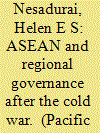

|
|
|
|
|
| Publication |
2009.
|
| Summary/Abstract |
This paper first reviews and critiques the dominant realist and constructivist accounts of ASEAN, which have enjoyed much prominence in The Pacific Review since the journal's founding in 1988. ASEAN behaviour and outcomes cannot be fitted into neat theoretical categories that emphasize either material or ideational variables in explanation. Instead, ASEAN displays complexities in behaviour that are the product of the contingent interaction between the material (power, territory, wealth) and the ideational (norms, ideas, identity) as member states actively seek to manage domestic order as well as regional order within and beyond ASEAN. In all of this, state interests and identities remain paramount, which means that the long-standing ASEAN norms of sovereignty/non-interference remain central to regional governance.
|
|
|
|
|
|
|
|
|
|
|
|
|
|
|
|
| 2 |
ID:
155097
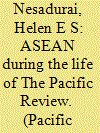

|
|
|
|
|
| Summary/Abstract |
Recent studies of ASEAN have focused on why ASEAN community building has emphasised liberal norms such as human rights, democracy promotion and a commitment to wider participation while maintaining a set of sovereignty-preserving regional principles – the ASEAN Way norms – that have been more suited to securing illiberal agendas and the authoritarian practices of state elites. ASEAN's seeming progressive turn is argued to be instrumentally aimed at buttressing the legitimacy of the grouping as a credible regional institution in international society in which these norms are widely accepted though not uncontested. With recent developments suggesting further consolidation of, or a return to, authoritarian tendencies across the region, state-based modes of governance may become more limited in terms of what ASEAN member states are prepared to endorse. It is, therefore, time for scholars to expand analysis to explore how transnational issues and problems may be functionally governed outside of formal regional institutions involving non-state actors in key roles. While the turn to privately generated standards, rules and practices in global governance is well-recognised and researched, the disparate studies on private governance in South-East Asia are rarely cumulated into a more coherent research programme that addresses the effectiveness of private governance as well as its normative implications. These questions point to a promising agenda for research on regional and other transnational modes of governance in South-East Asia.
|
|
|
|
|
|
|
|
|
|
|
|
|
|
|
|
| 3 |
ID:
084108
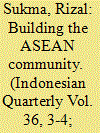

|
|
|
| 4 |
ID:
084316
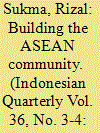

|
|
|
| 5 |
ID:
084109
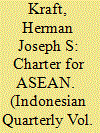

|
|
|
| 6 |
ID:
131352
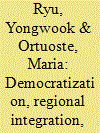

|
|
|
|
|
| Publication |
2014.
|
| Summary/Abstract |
The establishment of the Association of Southeast Asian Nations' (ASEAN) Intergovernmental Commission on Human Rights (AICHR) is extremely puzzling, because many ASEAN members have never been strong supporters of human rights, nor have they been advocates for intervening in the name of human rights. Why did ASEAN members, then, agree to establish the AICHR? We argue that the AICHR is the result of two factors: democratization in key regional countries and the intensifying effort of regional integration in the form of the ASEAN Community project. The former factor engendered key agents for pro-human rights initiatives and set the direction of human rights development within ASEAN. The latter factor weakened the old norms of the ASEAN Way and engendered new regional norms such as good governance and accountability, which were conducive to the development of human rights. It also provided persuasive power based on a shared sense of collective purpose in eliciting agreement from the authoritarian members for the AICHR. We support our argument with the analysis of all ASEAN vision statements and its ministerial meeting statements from 1967 to 2010 as well as our own interviews. The analysis shows that the emergence of new regional norms was closely associated with the development of the ASEAN Community project, and this normative change resulted in a different view of human rights, whose promotion would positively affect regional integration and stability. Our argument suggests a different perspective of a regional human rights mechanism essentially as a regional body reflecting regional norms and values.
|
|
|
|
|
|
|
|
|
|
|
|
|
|
|
|
| 7 |
ID:
123005


|
|
|
|
|
| Publication |
2013.
|
| Summary/Abstract |
Scholars have remarked that the decision-making process in the Association of Southeast Asian Nations (ASEAN) is largely elitist in nature and concentrated within the higher echelon of leadership, with little public participation. Since ASEAN is moving toward community building by the year 2015, questions arise on whether the people are consulted, aware, and support this initiative - which is the focus of this article. The authors argue that increased awareness and knowledge of the public regarding the ASEAN Community initiative will eventually translate into increased support. Against this background, this article analyzes the extent the public in Indonesia, Malaysia, and Singapore are aware of and support the proposed initiative, based on public opinion surveys conducted by the authors in these countries. To support the discussion, this article also employs the Pearson chi-square test to analyze the relationship between public awareness and support for the ASEAN Community.
|
|
|
|
|
|
|
|
|
|
|
|
|
|
|
|
| 8 |
ID:
174538


|
|
|
|
|
| Summary/Abstract |
This article examines the stages of establishing a Southeast Asian regional complex from the end of the 1940s to the present day. The prehistory of creating a regionwide organization that would allow the building of a collective regional identity is described. Insight is gained into the concept of creating the ASEAN community and its individual components. The historical evolution and current state of the mechanism by which ASEAN functions are described. It is noted that ASEAN's collective efforts to cultivate interregional ties, a conscious design of a special ASEAN identity within Southeast Asia facilitate the establishment of a regional complex.
|
|
|
|
|
|
|
|
|
|
|
|
|
|
|
|
| 9 |
ID:
104683


|
|
|
| 10 |
ID:
132402
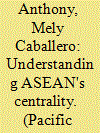

|
|
|
|
|
| Publication |
2014.
|
| Summary/Abstract |
There have been a number of articles about ASEAN's centrality in the regional security architecture of Asia. Yet, the notion of centrality remains undefined and under-operationalised. Implicit in the discourses of centrality is the idea of ASEAN's leadership, which in turn raises questions about ASEAN's ability to do so, given its limited capacity. This article defines ASEAN's centrality from the perspective of social network approach and argues that ASEAN's structural position in the density of networks that it has established and those that it has linkages with explains ASEAN's centrality. Despite its lack of material power, ASEAN has been able to claim centrality because of its position as a node in a cluster of networks, and this condition of 'high betweenness' allows ASEAN to exercise influence in regional processes with the tacit acceptance of major powers. However, while centrality may have been achieved, maintaining centrality in a rapidly changing regional environment compels ASEAN to address challenges to its centrality. This would necessarily include its ability to maintain consensus, carry out collective action and achieve its stated goals.
|
|
|
|
|
|
|
|
|
|
|
|
|
|
|
|